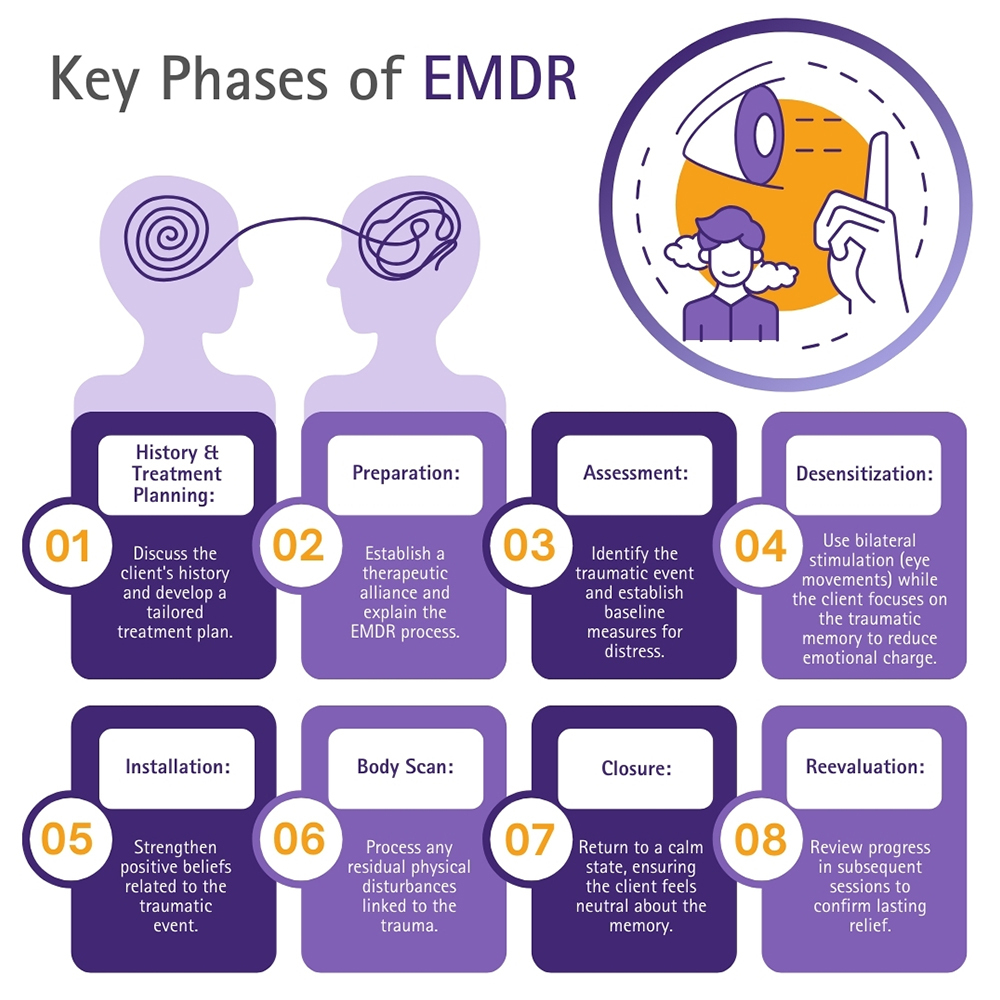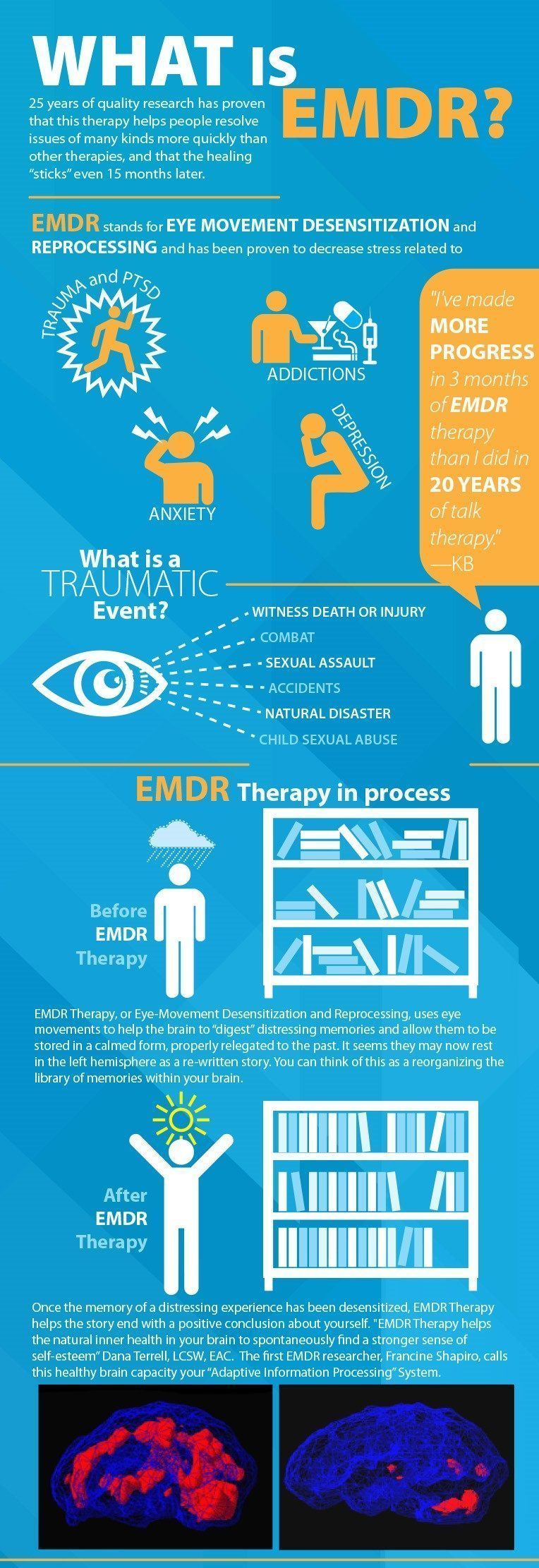Licensed emdr therapists nyc deliver direction for trauma recovery
Wiki Article
Exactly How EMDR Therapy Works: a Detailed Take A Look At the Refine and Its Performance
EMDR treatment has emerged as a famous treatment for trauma-related disorders. Its organized strategy consists of different phases made to promote the handling of upsetting memories. Central to this method is the principle of reciprocal excitement, which plays a necessary function in how memories are refined. Recognizing these aspects reveals much regarding the therapy's effectiveness. Nonetheless, what specifically occurs during an EMDR session, and just how does it affect the therapeutic trip?Recognizing the Principles of EMDR Therapy
EMDR treatment, or Eye Motion Desensitization and Reprocessing, operates on the facility that unresolved stressful experiences can impede psychological wellness. This innovative restorative approach intends to facilitate the handling of upsetting memories, allowing people to obtain a much healthier point of view on their past. Central to EMDR is the idea of reciprocal stimulation, normally achieved with led eye motions, which is thought to help incorporate stressful memories into a much more flexible framework.
The 8 Stages of EMDR Therapy
The process of EMDR therapy unfolds over 8 unique phases, each developed to guide customers via an organized strategy to recovery trauma. The first stage includes history-taking, where the therapist assesses the customer's background and identifies target memories. In the 2nd stage, clients learn leisure methods to manage distress. The 3rd phase concentrates on recognizing unfavorable beliefs connected with the distressing memory.The fourth stage is where the desensitization procedure begins, allowing customers to process the terrible memory. The fifth phase involves mounting positive beliefs to replace the negative ones. In the 6th phase, customers are led to examine their physical and psychological reactions to the refined memory. The seventh stage emphasizes closure, aiding clients go back to a state of equilibrium. The eighth phase entails reevaluation, where customers and therapists evaluate progression and deal with any kind of residual distress. This detailed method cultivates a pathway to healing and strength.
The Duty of Bilateral Excitement
Reciprocal excitement is a necessary component of EMDR therapy, facilitating the processing of distressing memories. This strategy involves alternating stimulation of both hemispheres of the mind, typically achieved via eye motions, auditory tones, or tactile sensations. The function of reciprocal excitement is to involve the mind's all-natural info handling system, which might become disrupted complying with injury.By turning on both sides of the mind, reciprocal excitement helps clients access and reprocess upsetting memories in a much more adaptive method. This technique urges the assimilation of stressful experiences, reducing their emotional charge and enabling clients to establish brand-new point of views.

Additionally, reciprocal excitement may promote leisure and lower anxiousness during sessions, creating a more secure setting for customers to face agonizing memories. Eventually, this technique enhances the healing process, allowing people to move toward recovery and resolution.
Evidence Supporting the Efficiency of EMDR
Research has revealed that EMDR click this link treatment is reliable in dealing with various emotional problems, particularly trauma (PTSD) Various studies have actually demonstrated substantial reductions in PTSD signs and symptoms adhering to EMDR treatment. A meta-analysis of randomized controlled tests found that EMDR was as reliable as cognitive behavioral treatment (CBT) for PTSD, with long lasting results observed even months after therapy. In addition, the American Psychological Association and the Globe Health Company recommend EMDR as a suggested therapy for trauma-related disorders.Beyond PTSD, study go to these guys indicates that EMDR can likewise profit individuals dealing with anxiousness, depression, and fears. An expanding body of proof supports its use in varied populaces, including experts and children - emdr therapy new york. Generally, the accumulating research study emphasizes EMDR's possible as a versatile therapeutic choice, leading the means for further expedition right into its devices and applications in psychological health treatment
What to Anticipate During an EMDR Session
During an EMDR session, clients can expect a structured yet versatile technique aimed at handling traumatic memories. The therapist begins by developing a secure setting, where customers can really feel comfy sharing their experiences. First conversations concentrate on identifying specific memories and associated negative beliefs.Clients are guided to concentrate on these memories while i thought about this at the same time participating in bilateral stimulation, normally with assisted eye motions or tapping. This dual focus intends to facilitate the processing of the injury, permitting customers to reframe their experiences and minimize emotional distress.
Throughout the session, therapists monitor customers' feedbacks, readjusting the speed and method as needed. Procedure might include relaxation techniques or cognitive restructuring to enhance favorable beliefs. Overall, customers can expect a helpful atmosphere that urges self-exploration and recovery, eventually leading to a better sense of emotional health.
Often Asked Concerns
Is EMDR Therapy Ideal for Children or Adolescents?
EMDR therapy can be suitable for adolescents and youngsters, provided it is adapted to their developing needs (emdr therapy). Medical professionals usually customize techniques to ensure safety and performance, supporting more youthful populations in handling trauma and psychological distressHow Lengthy Does EMDR Therapy Commonly Last?
EMDR therapy typically lasts in between 8 to 12 sessions, with each session varying from 60 to 90 mins. Specific needs and the complexity of injury can influence the total duration of treatment.
Can EMDR Therapy Be Done Remotely or Online?
EMDR therapy can undoubtedly be performed from another location or online. Numerous professionals have actually adjusted their approaches to virtual environments, enabling clients to take part in efficient sessions from the convenience of their homes, preserving healing advantages.What Are the Potential Adverse Effects of EMDR?
Prospective side impacts of EMDR therapy might include momentary emotional distress, heightened anxiousness, vivid memories, and physical pain. People could additionally experience exhaustion or frustrations adhering to sessions, as the mind refines extreme sensations and memories.Exactly How Does EMDR Compare to Conventional Talk Therapy?

EMDR therapy, or Eye Activity Desensitization and Reprocessing, runs on the facility that unresolved stressful experiences can impede emotional health. The process of EMDR therapy unravels over eight distinctive phases, each made to assist clients through a structured strategy to recovery trauma. Reciprocal excitement is a necessary part of EMDR therapy, promoting the processing of stressful memories. During an EMDR session, clients can anticipate an organized yet adaptable method aimed at handling traumatic memories. Prospective side results of EMDR therapy might consist of temporary emotional distress, increased anxiousness, dazzling memories, and physical pain.
Report this wiki page